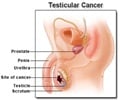About Varicocele
Varicocele is a condition that affects men and is often associated with decreased sperm count or infertility. It is said to affect about 15% of the male population. In this condition the veins draining the testis become enlarged and tortuous and appear prominent on the skin-surface of the scrotum. It can often cause a dragging sensation or pain on the hanging scrotum and is usually more common on the left side. The left testis hangs lower than the right testis but this is not the reason for it being more common on the left.
The word varicocele is a compound word from Latin and Greek. Latin Varic - Varix - means an abnormally dilated blood vessel and Kele - means tumor in Greek. The term "cirsocele" is also found in the older textbooks, however this is now replaced by the term "varicocele".
The diagnosis of varicocele is quite straightforward and is mostly done by examining the patient in a standing position. Ultrasound and a Doppler scan of the scrotum can confirm the diagnosis and also indicate the grade of the varicocele.
An unknown Greek physician first recognized this condition. Celsus, 2000 years ago advocated cauterization for superficial scrotal veins, if found to be in the form of a twisted mass or varix. In his time he was able to recognize all the modern diagnostic features of varicocele which included -
- Dilated tortuous veins,
- Lower position and smaller size of the affected testis:
He said:- "Now a varix, when in the scrotal skin, must be burnt with finely pointed cauteries, which penetrate into the veins themselves, but so that nothing deeper than the veins is burnt; the cautery is to be applied especially where the veins form a twisted mass."
Many of the ancient physicians advocated the removal of the affected testis to cure the problem.
The modern day treatment for gross varicocele is surgery - either by using a microscope or by laparoscopy and dividing the prominent veins. A small open surgical operation may also be a simple option to cure the problem.
Surgical treatment of varicocele that is associated with low sperm count has been controversial. It is generally felt that sub-clinical varicocele that are discovered by Doppler ultrasound studies of the scrotum should not be treated with an idea to improve sperm count. However gross varicoceles with low sperm counts can be taken up for surgical treatment.












